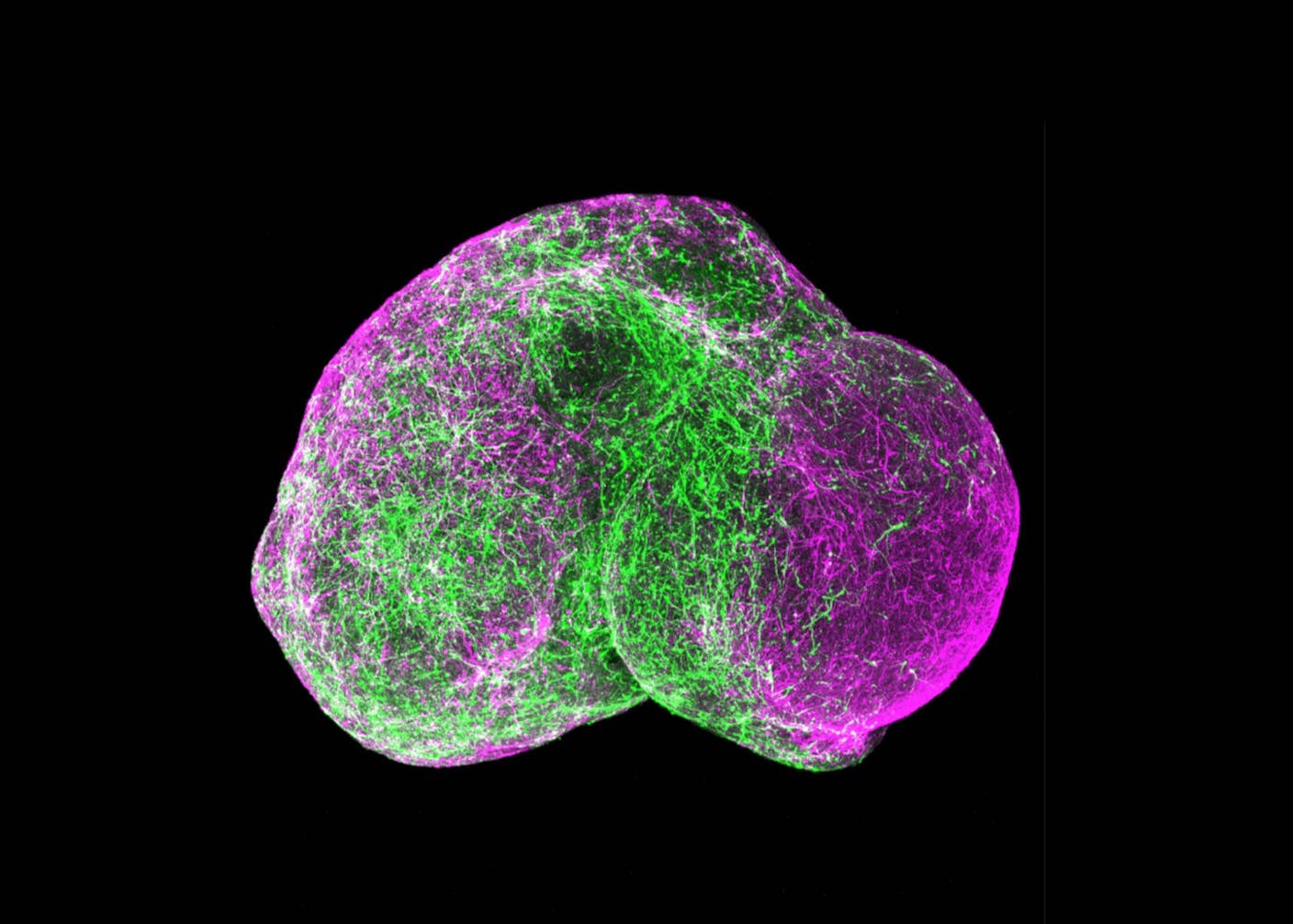Some Brains Develop Alzheimer’s—Others Don’t. A New Cell Map Could Explain Why.

Share
Alzheimer’s disease slowly takes over the mind. Long before symptoms occur, brain cells are gradually losing their function. Eventually they wither away, eroding brain networks that store memories. With time, this robs people of their recollections, reasoning, and identity.
It’s not the type of forgetfulness that happens during normal aging. In the twilight years, our ability to soak up new learning and rapidly recall memories also nosedives. While the symptoms seem similar, normally aging brains don’t exhibit the classic signs of Alzheimer’s—toxic protein buildups inside and surrounding neurons, eventually contributing to their deaths.
These differences can only be caught by autopsies, when it’s already too late to intervene. But they can still offer insights. Studies have built a profile of Alzheimer’s brains: Shrunken in size, with toxic protein clumps spread across regions involved in reasoning, learning, and memory.
However, those results only capture the very end of the journey.
This week, an international team led by Columbia University, MIT, and Harvard sought to map the entire process. Analyzing 437 donated brains from aging people—some with Alzheimer’s, others not—they peeked into the gene expression of 1.65 million brain cells in the regions most affected by Alzheimer’s and built a comprehensive cell atlas for aging brains.
A machine learning algorithm next teased apart the trajectories that differentiate Alzheimer’s from a normally aging brain. The team found a slew of genetic changes in multiple cell types that differed between the two. Some cell types controlled immunity; others supported metabolism.
“Our study highlights that Alzheimer’s is a disease of many cells and their interactions, not just a single type of dysfunctional cell,” said study author Dr. Philip De Jager in a press release.
With these results, “we provide a cellular foundation for a new perspective” on how Alzheimer’s develops, which could inform personalized treatments by targeting different brain cell communities, the authors wrote in the study.
“We may need to modify cellular communities to preserve cognitive function,” said Jager.
The Brainy Bunch
Our brains are a bit like a suburban community. Multiple types of neighboring cells help each other out.
Neurons are the best known. These spark with electricity and form the networks underlying our emotions, thoughts, and memories. But they don’t act alone.
Astrocytes—named for their star-like shape (pictured above)—nurture neurons with supportive molecules, especially when they need a metabolic boost. Meanwhile, microglia—the neighborhood watch committee—keep watch for signs of danger. A type of immune cell, these rapidly destroy bacteria, viruses, and other intruders. They’re also like “gardeners” for neurons, snipping away some connections to optimize neural networks as we learn.
In Alzheimer’s disease, this neighborliness breaks down. Microglia go rogue and increase inflammation. Astrocytes lose their function. Neurons wilt and die. The downward spiral happens over years, if not decades. By the time symptoms are obvious, it’s too late.
With over 400 brain samples, the new study aimed to find new treatments by charting the molecular journey of these brain cells.
Scientists have previously analyzed donated brains from people with and without Alzheimer’s. But they focused mostly on overall structure or zoomed in on molecular details. They didn’t chart the long journey of each individual cell’s role that, together, led to Alzheimer’s.
“Past studies have analyzed brain samples as a whole, and they lose all cellular detail,” said De Jager. “We now have tools to look at the brain in finer resolution, at the level of individual cells.”
Jager’s team aimed to find changes in multiple types of brain cells involved in the disease. They also used autopsies to reconstruct a chain of cause-and-effect: That is, finding the genes that translate brain cell changes into cognitive decline, and eventually, Alzheimer’s.
Brain Bank
The study tapped into a long-running source for data. The Religious Orders Study and the Rush Memory and Aging Project (ROSMAP), which began in the 1990s, enrolled people 65 years of age and older and captured their health and mental status each year using standardized tests for up to two decades. The project also welcomed brain donations, yielding a valuable biobank.
Here, the team analyzed brain tissues from over 400 people—some with Alzheimer’s, others not. They used a popular method to gauge how individual cells work called single cell RNA sequencing. The technology has taken biology research by storm with its ability to map gene expression—that is, which genes are turned on—in individual cells.
Be Part of the Future
Sign up to receive top stories about groundbreaking technologies and visionary thinkers from SingularityHub.


It’s especially useful when studying the brain. Our noggins are incredibly complex, with many different cell types working together. The technology offers a way to peek into the genetic workings of each type and decipher how they all fit together in a functional “neighborhood.”
By looking at individual neurons and cognition test results from the donors, “we can reconstruct trajectories of brain aging from the earliest stages of the disease,” said De Jager.
The brain samples spanned brain aging and Alzheimer’s—roughly 60 percent showed signs of the disease—and the team captured the genetic readouts of 1.6 million brain cells of all types.
Microglia, the brain’s immune cells, were shuffled into 16 different populations based on their sequencing results, with some previously linked to Alzheimer’s in a mouse model. Astrocytes, the brain’s supportive cells, also showed 10 distinct gene expression types.
The team also documented different neurons, blood vessel cells that feed the brain, and other supporting cells that help maintain the brain’s overall structure.
Algorithm to Alzheimer’s
To make sense of the data, the team developed an algorithm to link different subpopulations of cells to the disease. They focused on three main problems related to Alzheimer’s. The first two are the presence of toxic protein clumps inside and outside of neurons. The third is the rate of cognitive decline before death.
With a custom-designed algorithm called BEYOND, the team sifted through the database and found two trajectories for aging brains. One aged normally, while the other showed signs of Alzheimer’s, with increased toxic protein buildup and cognitive decline. No single brain cell type, by itself, was the villain—rather, the whole community spiraled out of control.
During the disease’s early stages, a subset of microglia ramped up. These cells increased inflammation and accumulated toxic proteins.
“We propose that two different types of microglial cells—the immune cells of the brain—begin the process of amyloid and tau accumulation that define Alzheimer’s disease,” said De Jager.
The cells then triggered an Alzheimer’s cascade. A subset of astrocytes—the brain’s supporting cells—were the first victim, as they frantically tried to increase the activity of protective genes. Based on the analysis, astrocytes may be key to differentiating Alzheimer’s and aging.
The algorithm predicted these types of cells may be a “point of convergence” for processes that lead to dementia, as opposed to normal brain aging. Knowing how individual cells contribute to Alzheimer’s—and their journey into the disease—makes it possible to target specific cellular communities with new therapies to tackle both problems.
“These are exciting new insights that can guide innovative therapeutic development for Alzheimer’s and brain aging,” said De Jager.
Image Credit: Kevin Richetin / University of Lausanne via Flickr
Dr. Shelly Xuelai Fan is a neuroscientist-turned-science-writer. She's fascinated with research about the brain, AI, longevity, biotech, and especially their intersection. As a digital nomad, she enjoys exploring new cultures, local foods, and the great outdoors.
Related Articles

Time Doesn’t Really Flow—Your Brain Just Makes You Think It Does

How Will the Universe End? The Dark Eternity That Awaits Us Trillions of Years From Now

Five-Year-Old Mini Brains Can Now Mimic a Kindergartener’s Neural Wiring. It’s Time to Talk Ethics.
What we’re reading